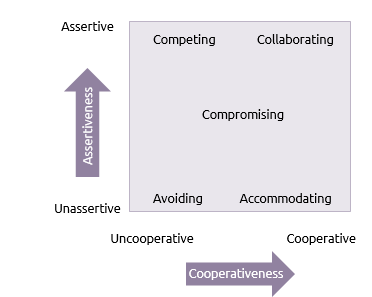Kenneth Thomas and Ralph Kilmann based their conflict style inventory on the managerial grid developed by Blake and Mouton. They arranged five conflict resolution approaches on scales of two individual characteristics: assertiveness and cooperativeness.
 They also developed the Thomas-Kilmann Conflict Mode Instrument that is used to identify an individual’s natural tendencies when dealing with conflict.
They also developed the Thomas-Kilmann Conflict Mode Instrument that is used to identify an individual’s natural tendencies when dealing with conflict.
- Competing
-
People who favour this style tend to take a firm stand because they are confident in their position. They often operate from a position of power.
-
The style is useful when the conflict needs to be resolved urgently; when the solution is unpopular or when the other party is trying to exploit a situation to their own advantage.
Care must be taken not to use this style inappropriately as some people will feel they have lost an argument and will be resentful.
- Collaborating
-
The collaborative style tries to meet the needs of everyone involved. Someone who adopts this style can still be assertive but, unlike the ‘competitor’ they acknowledge everyone’s views have equal importance. This style tries to bring together many viewpoints to arrive at the best solution and should be the first style employed, for example, when resolving conflicts during requirements management.
- Compromising
-
Compromise often means that all parties feel only partially satisfied. Compromise means everyone has to give up something but is useful when the impact of the conflict on project, programme or portfolio objectives outweighs the effects of breaking the impasse between equal parties. This approach is most likely to be used during the delivery phase of the life cycle.
- Accommodating
-
This style indicates that someone is prepared to meet the needs of others and the expense of their own needs. This is unlikely to be a suitable style for a P3 manager whose primary interest is to meet the needs (objectives) of the project, programme or portfolio. It should only be adopted if it is the only way to resolve a conflict and the impact of non-resolution is worse than the necessary concessions.
- Avoiding
-
People who prefer this style seek to evade the conflict or pass it on to another. The only situations where this can really be acceptable are where a P3 manager genuinely believes that someone else is better placed to resolve a conflict.
-
It would be perfectly reasonable, for example, for a P3 manager to pass responsibility for resolving a conflict with a senior stakeholder to the sponsor – but in a structured way, not just ignoring the problem and hoping the sponsor will resolve it.





